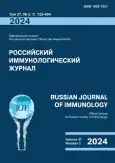Экспериментальная модель легочного фиброза у мышей, индуцированная посредством аэрозольной доставки LPS
- Авторы: Намаканова О.А.1, Губернаторова Е.О.1, Чичерина Н.Р.2, Зварцев Р.В.1, Друцкая М.С.1,2
-
Учреждения:
- ФГБУН «Институт молекулярной биологии имени В.А. Энгельгардта» Российской академии наук
- АНOО ВО «Научно-технологический университет “Сириус”»
- Выпуск: Том 27, № 2 (2024)
- Страницы: 145-150
- Раздел: КРАТКИЕ СООБЩЕНИЯ
- URL: https://journals.rcsi.science/1028-7221/article/view/263658
- DOI: https://doi.org/10.46235/1028-7221-16876-EMM
- ID: 263658
Цитировать
Полный текст
Аннотация
Повреждение легких, вызванное воздействием липополисахарида (LPS), является наиболее часто используемой моделью острого воспаления легочной ткани у мышей, что позволяет имитировать развитие синдрома респираторного расстройства у человека. Эффекты индуцированного экспериментального острого LPS-зависимого воспаления дыхательных путей хорошо изучены и связаны с накоплением нейтрофилов в бронхоальвеолярной жидкости (БАЛ), локальной и системной продукцией провоспалительных цитокинов, а также сужением просвета дыхательных путей. В последнее время появляется все больше исследований, показывающих наличие признаков легочного фиброза, таких как усиленная пролиферация фибробластов и избыточное отложение внеклеточного матрикса на поздних стадиях острого воспаления легких, вызванного воздействием LPS. В данной работе описана экспериментальная модель острого повреждения легких, индуцированная с помощью однократного аэрозольного введения LPS в качестве воспроизводимой in vivo модели легочного фиброза. Для этого мышей линии C57BL/6 помещали в камеру, и с помощью распылителя Aeroneb Lab Nebulizer подвергали воздействию аэрозоля, содержащего 10 мг LPS.
Было установлено, что через 5 недель после однократного ингаляционного введения LPS мыши демонстрировали повышенную продукцию IL-6 в БАЛ. Несмотря на то, что количество нейтрофилов не изменялось, на 5-й неделе после воздействия LPS происходило снижение процентного содержания альвеолярных макрофагов, что может свидетельствовать о продолжающемся локальном воспалении. В то же время доставка LPS с помощью аэрозольной установки, спустя несколько недель, приводило к увеличению продукции и экспрессии ключевых медиаторов фиброза, таких как повышенной продукции IL-10 в БАЛ, увеличенной экспрессии Tgfb1, Col1a1, Il13 и Acta2, а также отложению коллагена в легочной ткани по сравнению с мышами с острым воспалением легких.
Таким образом, использование метода однократного введения LPS с помощью небулайзера представляет собой релевантную, воспроизводимую и физиологичную модель на мышах, что в дальнейшем позволит исследовать механизмы развития фиброза легких и поможет в поиске новых терапевтических средств и подходов.
Ключевые слова
Полный текст
Открыть статью на сайте журналаОб авторах
О. А. Намаканова
ФГБУН «Институт молекулярной биологии имени В.А. Энгельгардта» Российской академии наук
Автор, ответственный за переписку.
Email: olga.namakanova@gmail.com
младший научный сотрудник Центра высокоточного редактирования и генетических технологий для биомедицины
Россия, МоскваЕ. О. Губернаторова
ФГБУН «Институт молекулярной биологии имени В.А. Энгельгардта» Российской академии наук
Email: olga.namakanova@gmail.com
старший научный сотрудник Центра высокоточного редактирования и генетических технологий для биомедицины
Россия, МоскваН. Р. Чичерина
АНOО ВО «Научно-технологический университет “Сириус”»
Email: olga.namakanova@gmail.com
студент, магистр направления «Иммунобиология и биомедицина»
Россия, Федеральная территория «Сириус», Краснодарский крайР. В. Зварцев
ФГБУН «Институт молекулярной биологии имени В.А. Энгельгардта» Российской академии наук
Email: olga.namakanova@gmail.com
младший научный сотрудник Центра высокоточного редактирования и генетических технологий для биомедицины
Россия, МоскваМ. С. Друцкая
ФГБУН «Институт молекулярной биологии имени В.А. Энгельгардта» Российской академии наук; АНOО ВО «Научно-технологический университет “Сириус”»
Email: olga.namakanova@gmail.com
д.б.н., ведущий научный сотрудник Центра высокоточного редактирования и генетических технологий для биомедицины; доцент
Россия, Москва; Федеральная территория «Сириус», Краснодарский крайСписок литературы
- Bain C.C., MacDonald A.S. The impact of the lung environment on macrophage development, activation and function: diversity in the face of adversity. Mucosal Immunol., 2022, Vol. 15, no. 2, pp. 223-234.
- Byrne A.J., Maher T.M., Lloyd C.M. Pulmonary macrophages: a new therapeutic pathway in fibrosing lung disease? Trends Mol. Med., 2016, Vol. 22, no. 4, pp 303-316.
- de Souza Xavier Costa N., Ribeiro Junior G., Dos Santos Alemany A.A., Belotti L., Zati D.H., Frota Cavalcante M., Matera Veras M., Ribeiro S., Kallas E.G., Nascimento Saldiva P.H., Dolhnikoff M., Ferraz da Silva L.F. Early and late pulmonary effects of nebulized LPS in mice: An acute lung injury model. PLoS One, 2017, Vol. 12, no. 9, e0185474. doi: 10.1371/journal.pone.0185474.
- Frangogiannis N. Transforming growth factor-beta in tissue fibrosis. J. Exp. Med., 2020, Vol. 217, no. 3, e20190103. doi: 10.1084/jem.20190103.
- Kolahian S., Fernandez I.E., Eickelberg O., Hartl D. Immune mechanisms in pulmonary fibrosis. Am. J. Respir. Cell Mol. Biol., 2016, Vol. 55, no. 3, pp. 309-322.
- Mizgerd J.P., Skerrett S.J. Animal models of human pneumonia. Am. J. Physiol. Lung Cell. Mol. Physiol., 2008, Vol. 294, no. 3, pp. L387-L398.
- Nakagome K., Dohi M., Okunishi K., Tanaka R., Miyazaki J., Yamamoto K. In vivo IL-10 gene delivery attenuates bleomycin induced pulmonary fibrosis by inhibiting the production and activation of TGF-beta in the lung. Thorax, 2006, Vol. 61, no. 10, pp. 886-894.
- Schmittgen T.D., Livak K.J. Analyzing real-time PCR data by the comparative C(T) method. Nat. Protoc., 2008, Vol. 3, no. 6, pp. 1101-1108.
- Tsikis S.T., Fligor S.C., Hirsch T.I., Pan A., Yu L.J., Kishikawa H., Joiner M.M., Mitchell P.D., Puder M. Lipopolysaccharide-induced murine lung injury results in long-term pulmonary changes and downregulation of angiogenic pathways. Sci. Rep., 2022, Vol. 12, no. 1, 10245. doi: 10.1038/s41598-022-14618-8.
- Zheng M., Li H., Sun L., Brigstock D.R., Gao R. Interleukin-6 participates in human pancreatic stellate cell activation and collagen I production via TGF-beta1/Smad pathway. Cytokine, 2021, Vol. 143, 155536. doi: 10.1016/j. cyto.2021.155536.
Дополнительные файлы









